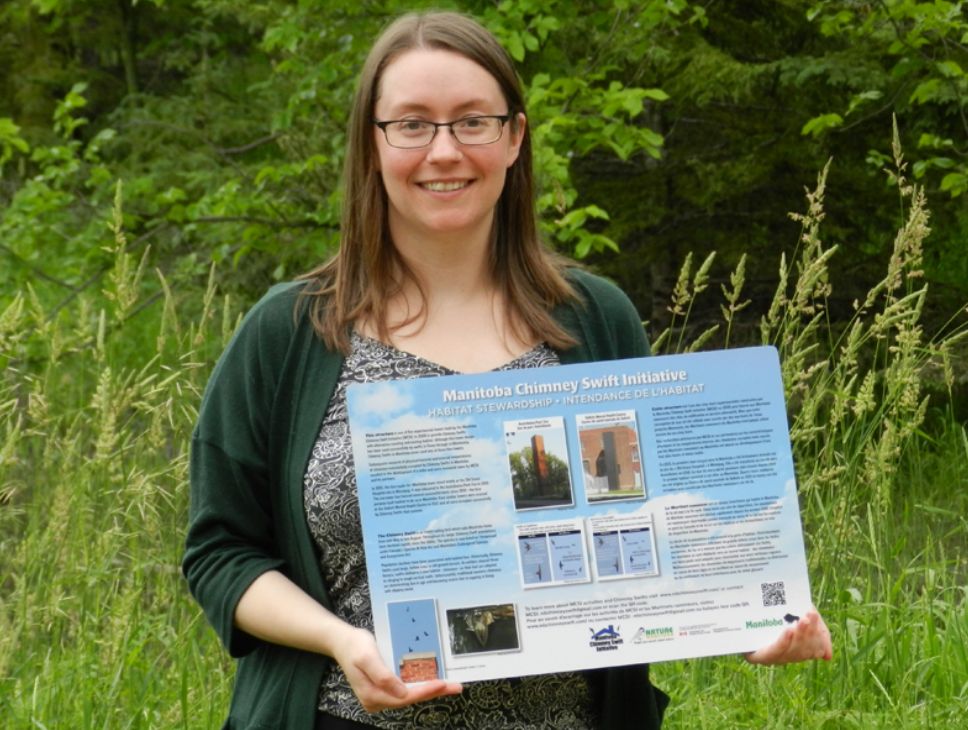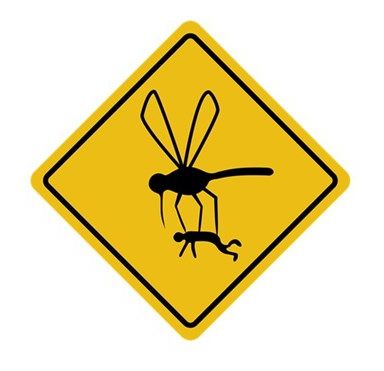
Just a friendly reminder that another wonderful Wednesday MCSI Swift Watch Day has arrived. After your monitoring sessions at nest and/or roost sites, fly those monitoring reports over to us. Next week, Ariel will provide an update on all the action you have observed.
Today, I have an omnibus blog for you. The past week was full of swift action and activities to share…
Amanda was flying in high gear on our behalf during her last full week as our Coordinator. Thanks for all of your continued hard work Amanda!
Early in the week, a new plaque for the original 2008-built artificial tower in St Adolphe was delivered; installation of the plaque will take place later in the month. New signage will also be installed at the old Portage La Prairie artificial tower. These new habitat stewardship plaques update our significant achievement = MCSI has developed a successful made-for-Manitoba artificial tower! You can visit the Assiniboine Park Zoo to see all the swift action at the new tower and/or check out the MCSI website at: https://www.mbchimneyswift.com/chimney-swift-towers/

At week’s end, Amanda released MCSI’s latest monitoring info-sheet. The two-sided sheet provides the basic W5 approach to monitoring Chimney Swifts in our province. It also describes the various MCSI programs and how volunteer monitors fit into those different activities. Our fast-flying webmaster, Frank Machovec, has created a link to the document in the Resources and Links section of our website. Head to: https://www.mbchimneyswift.com/Documents/factsheet_volunteer.pdf
In other news, two new sites have been identified! Tim, The Swift Magnet Man, saw aerial activity in Dauphin during the day that led him to St Paul’s Anglican Church in the evening. Entries to a lovely chimney were seen! St Paul’s, in addition to the other sites in Dauphin, will be monitored by the keen eyes of Ken, Jan, Pat & Marilyn. In The Pas, many days of sleuthing led Joel to locate a new nest site at the Frontier Apartments. Well done! Those new sites are great additions to our site inventory database. We know there are more Manitoba sites of interest that need locating, so keep your eyes to the sky (it’s one of the activities mentioned in the new volunteer monitoring sheet!).
Continued monitoring of old faithful sites has been done by many monitors…as promised, we’ll hear about it in Ariel’s update next week.
It is enjoyable to monitor single sites as an event on its own. But a different layer of opportunity comes with the ability to compare and contrast activity between sites. That evaluation of absolute vs relative activity is really useful to get an idea of seasonal trends and geographic variation in phenology (dates of nesting stages) etc.
The Selkirk Mental Health Centre (SMHC) complex now boasts 4 new artificial towers in addition to 2 old masonry chimneys on brick buildings. With that cluster of chimneys, it is interesting to compare the SMHC Chimney Swift’s breeding activity to that seen in the 5 St Adolphe nest sites situated along the main road (a 6th site in a private home, ~1 km away, is tracked less intensively). We will cross-reference activity more as the season goes along. When earnest feeding is apparent at more sites, it will be easier to look at some time lines for fledging to see how harmonized the Selkirk and St Adolphe birds are in their breeding efforts.
We know that the St Adolphe swifts currently are lagging behind last years’ time line for hatching. In 2021, hatching took place on July 3rd (Brodeur Bros./Daycare), July 5th (Church), July 6th (NE Club Amical) and July 7th (SE Club Amical; Main St.).
This year in St Adolphe, only one site had hatched by July 10th. The NE Club Amical breeding pair started feeding their hatchlings on July 1st which was earlier than any of the 2021 hatch dates.
I have re-evaluated the activity in the SE Club Amical site after the helper left for the Church site last Wednesday, July 6th (the helper only made a very brief appearance there). Once the cadence of the breeding pair was reestablished at the SE Club Amical chimney, it appeared that incubation was taking place – still good news, but not the stage of nesting that the activity pattern of 3 adults portrayed. You have to go with what the swifts show you and be prepared to come up with an alternate explanation.
Another highlight of the past monitoring week included the transition to feeding non-brooded young at the NE Club Amical site. Here’s what that data looked like on Day 8 of feeding (which conveniently was July 8th) when I watched the rim for 90 min. starting at 10:43 AM: entry at 10:49:43; exit at 10:50:13; entry at 11:06:21; exit at 11:07:07; entry at 11:27:06; exit at 11:27:35; entry at 11:43:46; exit at 11:45:16; entry 12:06:26; exit at 12:07:02. The feeding rate was 3-4 X hour.
By comparison, here’s what the SE Club Amical breeding pair did during that same time on July 8th: entry at 11:12:08; exit at 11:13:21.
The behaviour of flying Chimney Swifts can telegraph important out-of-sight developments inside the chimney. A group of 8-9 swifts was busy racing around the Brodeur Bros./Daycare area on the afternoon of Monday, July 11th. Repeatedly, a string of ~3-4 birds or single swifts approached the rim – some dropped down low then banked off, others sped in before veering off on the same plane, and some birds flew low in a straight path and moved their heads as they passed over the rim. This behaviour was investigative in nature – curiosity driven – and it sure seemed to telegraph “something” was going on…monitoring on Tuesday, July 12th revealed what that “something” was. Eggs have hatched!
While Monday’s entry/exit activity rate at Brodeur Bros./Daycare was 1 X hour, Tuesday’s activity rate was higher. For a 90 min. session between 10:37 AM and 12:07 PM, I saw these events: entry at 10:40:00; exit at 10:40:34; entry at 11:12:12 (between-visit interval = 31 min.); exit at 11:13:07; entry at 12:08:57 (between-visit interval = 56 min.); exit at 12:09:45. Note that the time between-visits stretched out towards noon…it was getting hotter and muggier. But if you look at two blocks of 60 minutes (10:37-11:37; 11:07-12:07) the rate of activity was = 2 X hour for each of the blocks. I’m happy declaring that hatching took place between July 11-12th at this site.

Now it’s time to wish you all the best for a successful swift quest today. We look forward to hearing about your experiences!
- Barb, for the MCSI Team
